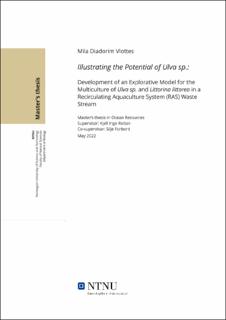| dc.description.abstract | The cultivation of seaweed species in fishpond effluent, characterized by high ammonium concentrations, has shown to successful and often high removal efficiencies can be attained. However, the high nitrate concentration from RAS wastewater could impact this potential due to the additional energy seaweed requires to take up this nutrient. To explore the effects of RAS wastewater on Ulva sp., this thesis examined the cultivation potential, uptake and removal efficiency. To illustrate how the additionally cultivated Ulva sp. biomass could be utilized, an explorative model has been developed that examined the co-culture of Ulva sp. and Littorina littorea in RAS wastewater.
This study demonstrated that Ulva sp. cultivated in the wastewater of a RAS facility, showed enhanced growth and chemical composition, compared to Ulva sp. cultivated in artificial seawater. On average, the specific growth rate and protein value were 337 and 319 % higher, respectively. Additionally, both the C:N and N:P ratios in the tissue showed to be around optimal levels of approximately 1:9 and 1:28, respectively. This study found that varying concentrations between 100-25% RAS wastewater in the cultivation medium did not significantly affect these results. However, trends in the growth and chemical composition displayed that 25% RAS wastewater concentration produced the largest growth over time and the highest protein contents compared to 100% RAS water concentration. The uptake experiments showed that Ulva sp. can successfully take up nitrate and could attain removal efficiencies between 55- 80%, with a specific uptake rate between 5600 and 2500 µg NO3- g DW-1 day-1, respectively. This specific uptake rate and removal efficiency, in comparison to the ammonium, were 330 and 2 times higher, respectively. The high nutrient uptake of NO3- showed that the bioremediation potential of Ulva sp. is not limited to ammonium rich water.
To demonstrate how the additional biomass could be used, an explorative co-culture with Ulva sp. and L. littorea in RAS wastewater was simulated. Over a five-year period, using a biomass of 1344 kg FW Ulva sp. cultivated in RAS wastewater, more than 300 000 snails could be harvested. The explorative model showed that the snails can continuously graze on the seaweed biomass and that over a five-year period could be harvested at a steady rate. The robustness scenarios showed that reducing both mortality of Ulva sp. biomass and L. littorea offered most opportunities to increase output, whilst maintaining the same input. | |
